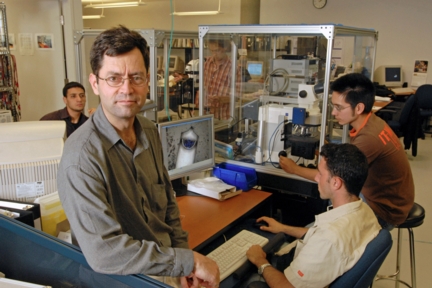Home > Press > The Fantastic Voyage Continues! - World first for Professor Sylvain Martel's team: localized delivery of an anti-cancer drug by remote-controlled microcarriers
 |
Abstract:
Fantastic Voyage: from science fiction to reality? École Polytechnique de Montréal researchers successfully control and navigate a wireless device inside an artery using a clinical magnetic resonance imaging (MRI) system, paving the way for novel, minimally invasive and more accurate surgeries
The Fantastic Voyage Continues! - World first for Professor Sylvain Martel's team: localized delivery of an anti-cancer drug by remote-controlled microcarriers
Montreal, Canada | Posted on March 17th, 2011Some 40 years after the release of the classic science fiction movie Fantastic Voyage, researchers in the NanoRobotics Laboratory of École Polytechnique de Montréal's Department of Computer Engineering and Institute of Biomedical Engineering have achieved a major technological breakthrough in the field of medical robotics. They have succeeded for the first time in guiding, in vivo and via computer control, a microdevice inside an artery, at a speed of 10 centimetres a second.
Under the direction of Professor Sylvain Martel, holder of the Canada Research Chair in Micro/Nanosystem Development, Construction and Validation, and in collaboration with researchers at the Centre hospitalier de l'Université de Montréal (CHUM), the Polytechnique team has succeeded in injecting, propelling and controlling by means of software programs an initial prototype of an untethered device (a ferromagnetic 1.5- millimetre-diameter sphere) within the carotid artery of a living animal placed inside a clinical magnetic resonance imaging (MRI) system.
Encouraged by these results, staff at the Polytechnique NanoRobotics Laboratory are currently working to further reduce the size of the devices so that, within a few years, they can navigate inside smaller blood vessels.
"Injection and control of nanorobots inside the human body, which contains nearly 100,000 kilometres of blood vessels, is a promising avenue that could enable interventional medicine to target sites that so far have remained inaccessible using modern medical instruments such as catheters," Professor Martel explained. "In collaboration with our scientific partners, Polytechnique researchers have begun developing several types of micro- and nanodevices for novel applications, such as targeted delivery of medications to tumour sites and diagnoses using navigable bio-sensors."
The results of this scientific breakthrough were published by Professor Martel and 10 co-authors from École Polytechnique de Montréal and the CHUM on March 14 in the scientific journal Applied Physics Letters.
Patent applications have been submitted for this method of real-time monitoring and guidance of devices for minimally invasive surgeries using MRI. Commercialization of the technology has been entrusted to Gestion Univalor, LP.
####
About Ecole Polytechnique de Montreal
Founded in 1873, École Polytechnique de Montréal is one of Canada's leading engineering institutions in terms of both teaching and research. It is the largest engineering school in Québec as far as its student population and the scope of its research activities are concerned. École Polytechnique provides instruction in 11 engineering specialties and is responsible for more than one-quarter of university research in engineering in Québec. The school has 230 professors and nearly 6,000 students. Its operating budget is $85 million, in addition to a $68-million research and infrastructure fund, which includes grants and contracts worth $38 million. Polytechnique is affiliated with Université de Montréal.
For more information, please click here
Contacts:
Annie Touchette
Communications and Recruitment Office
École Polytechnique de Montréal
Tel.: 514 340-4711 # 4415
Copyright © Ecole Polytechnique de Montreal
If you have a comment, please Contact us.Issuers of news releases, not 7th Wave, Inc. or Nanotechnology Now, are solely responsible for the accuracy of the content.
| Related News Press |
News and information
![]() Researchers develop molecular qubits that communicate at telecom frequencies October 3rd, 2025
Researchers develop molecular qubits that communicate at telecom frequencies October 3rd, 2025
![]() Next-generation quantum communication October 3rd, 2025
Next-generation quantum communication October 3rd, 2025
![]() "Nanoreactor" cage uses visible light for catalytic and ultra-selective cross-cycloadditions October 3rd, 2025
"Nanoreactor" cage uses visible light for catalytic and ultra-selective cross-cycloadditions October 3rd, 2025
Lab-on-a-chip
![]() Micro-scale opto-thermo-mechanical actuation in the dry adhesive regime Peer-Reviewed Publication September 24th, 2021
Micro-scale opto-thermo-mechanical actuation in the dry adhesive regime Peer-Reviewed Publication September 24th, 2021
![]() Silicon-graphene hybrid plasmonic waveguide photodetectors beyond 1.55 μm March 13th, 2020
Silicon-graphene hybrid plasmonic waveguide photodetectors beyond 1.55 μm March 13th, 2020
Discoveries
![]() Researchers develop molecular qubits that communicate at telecom frequencies October 3rd, 2025
Researchers develop molecular qubits that communicate at telecom frequencies October 3rd, 2025
![]() Next-generation quantum communication October 3rd, 2025
Next-generation quantum communication October 3rd, 2025
![]() "Nanoreactor" cage uses visible light for catalytic and ultra-selective cross-cycloadditions October 3rd, 2025
"Nanoreactor" cage uses visible light for catalytic and ultra-selective cross-cycloadditions October 3rd, 2025
Announcements
![]() Rice membrane extracts lithium from brines with greater speed, less waste October 3rd, 2025
Rice membrane extracts lithium from brines with greater speed, less waste October 3rd, 2025
![]() Researchers develop molecular qubits that communicate at telecom frequencies October 3rd, 2025
Researchers develop molecular qubits that communicate at telecom frequencies October 3rd, 2025
![]() Next-generation quantum communication October 3rd, 2025
Next-generation quantum communication October 3rd, 2025
![]() "Nanoreactor" cage uses visible light for catalytic and ultra-selective cross-cycloadditions October 3rd, 2025
"Nanoreactor" cage uses visible light for catalytic and ultra-selective cross-cycloadditions October 3rd, 2025
|
|
||
|
|
||
| The latest news from around the world, FREE | ||
|
|
||
|
|
||
| Premium Products | ||
|
|
||
|
Only the news you want to read!
Learn More |
||
|
|
||
|
Full-service, expert consulting
Learn More |
||
|
|
||








